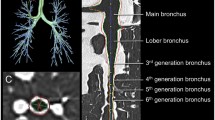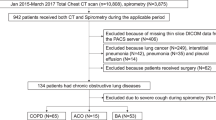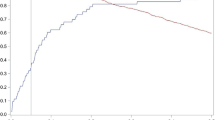Abstract
During acute asthma reversible increase in lung compliance and total lung capacity (TLC) have been observed. The magnitude of the increase in TLC, however, was found to be relatively small when TLC was measured radiographically. We wondered if structural distortion of the respiratory bellows develops during acute asthma attacks, accounting for the limited increase in TLC. We analyzed the chest wall dimensions using chest roentgenograms obtained in 32 patients who had previously participated in the study of radiographic evaluation of TLC. We found that the dimensional changes accompanying the small increase in TLC during acute asthma were nonuniform, consisting of mainly an increase in lung height (0.45 ± 0.15 cm) with limited coordinated expansion of other dimensions and a small but significant distortional contraction of lung width at the lowest portion of the rib cage (−0.25 ± 0.12 cm). These findings were interpreted to mean that in response to the decrease in elastic lung recoil (internal load) occurring during acute asthma, the diaphragm makes limited but effective further caudad descent without provoking serious structural distortion and that rib cage muscles, working at mechanical disadvantage at high lung volume, act largely as fixators.
Similar content being viewed by others
References
Gold WM, Kaufman HS, Nadel JA (1967) Elastic recoil of the lungs in chronic asthmatic patients before and after therapy. J Appl Physiol 23:433–438
Hershenson MB, Kikuchi Y, Loring SH (1988) Relative strength of the chest muscles. J Appl Physiol 65:852–862.
Loring SH, Mead J (1982) Action of the diaphragm on the rib cage inferred from a force-balance analysis. J Appl Physiol 53:756–760
Loyd HM, String ST, Dubois AB (1966) Radiographic and plethysmographic determination of total lung capacity. Radiology 86:7–14
Mead J, Loring SH (1982) Analysis of volume displacement and length changes of the diaphragm during breathing. J Appl Physiol 53:750–755
Peress L, Sybrecht G, Machlem PT (1976) The mechanism of increase in total lung capacity during acute asthma. Am J Med 61:165–169
Rothstein MS, Zelefsky MN, Eichacker PQ, Rudolph DJ, Williams MH Jr (1989) Radiographic measurement of total lung capacity in acute asthma. Thorax 44:510–512
Shore S, Millic-Emili J, Martin JG (1982) Reassessment of body plethysmographic technique for the measurement of thoracic gas volume in asthmatics. Am Rev Respir Dis 126:515–520
Stanescu DC, Rodenstein DO, Canberghs M, Van de Woestijne KP (1982) Failure of body plethysmograph in bronchial asthma. J Appl Physiol 52:938–948
Walsh JM, Webber CL Jr, Fahey PJ, Sharp JT (1992) Structural change of the thorax in chronic obstructive pulmonary disease. J Appl Physiol 72:1270–1278
Woolcock AG, Read J (1966) Lung volume in exacerbations of asthma. Am J Med 41:259–273
Author information
Authors and Affiliations
Additional information
Offprint requests to: S. S. Park
Rights and permissions
About this article
Cite this article
Park, S.S., Stein, L. & Zelefsky, M.N. Chest wall configuration assessed at total lung capacity during acute asthma and after recovery. Lung 171, 53–57 (1993). https://doi.org/10.1007/BF00177642
Accepted:
Issue Date:
DOI: https://doi.org/10.1007/BF00177642




